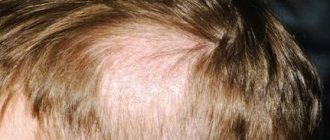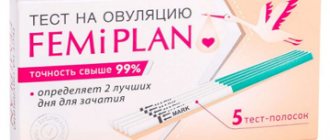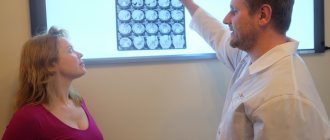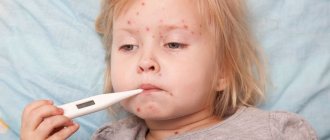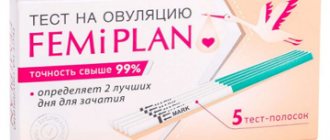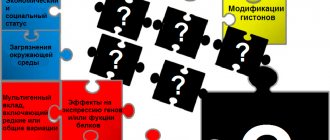Causes
Before starting treatment for erythema in children, this disease should be accurately diagnosed and the causative agent identified. The thing is that this anomaly is often confused with other skin diseases - rubella, urticaria, dermatitis, etc. But this pathology requires certain therapy, so a correct diagnosis is extremely important.
The main cause of erythema in children, or rather redness of the skin, is dilation of the capillaries. But this is achieved by other factors that affect the child’s body both externally and internally. Due to the structural features of the dermis, this disease is not uncommon in children. The thing is that their blood vessels are located quite close to the surface, to the epidermis itself. And any provoking factor causes rapid expansion of small vessels. This is what leads to redness of the skin.
A large number of erythemas have completely normal, natural and safe causes. Redness on the skin in children may appear as a reaction to touch, including massage. At elevated air temperatures (in a bathhouse or sauna), capillaries can also respond - expand. Erythema appears in a child during active games or sports. The explanation is quite simple - the blood supply becomes more intense, and under blood pressure the capillaries become larger.
But the pathological causes of this disease are determined by:
- infectious diseases that the child had or has;
- chemical burns;
- thermal burns;
- allergic reactions;
- post-traumatic changes that are observed in the skin;
- diseases occurring against the background of elevated body temperature.
When should you see a doctor?
At the first symptoms of erythema in children, you should contact a highly specialized physician. Allergists treat such pathologies. They carry out an external examination, give directions for certain tests, and make a conclusion. Based on it, the diagnosis is either confirmed or refuted.
If you are looking for an experienced specialist, we recommend contacting JSC “Medicine” (clinic of academician Roitberg), located in the central district of Moscow at the address: 2nd Tverskoy-Yamskaya lane 10. Our clinic is located near the Mayakovskaya, Belorusskaya, Novoslobodskaya metro stations , Tverskaya, Chekhovskaya.
But what symptoms indicate erythema in children? Let's take a closer look.
Types and symptoms
This pathology can be of several types. Moreover, erythema in a child varies in its external manifestations, symptoms and causes of capillary dilation.
There are two groups:
- physiological;
- pathological
And if physiological erythema develops against the background of emotional outbursts, when exposed to the skin, or when taking drugs that dilate blood vessels, then with pathological erythema everything is much more complicated. The main types of this anomaly belong specifically to this group.
Ring-shaped
Ring-shaped erythema in children is also called persistent erythema. It is characterized by the formation of spots on the skin that have a ring shape. Clearer and brighter edges, a pinkish center - this is what ring-shaped erythema looks like in children.
The main locations of formation are shoulders, cheeks, torso. Redness of the same type often appears with a bacterial or viral disease, as well as with rheumatism. But there is a special form of ring erythema in children - Daria's erythema. It is caused by the appearance of pink spots that continue to grow. They can either peel off or not violate the integrity of the skin. The reasons for its appearance still remain unknown. Often such ring-shaped erythema appears suddenly in children. Moreover, its development can also stop abruptly. Literally in a couple of hours.
But what are the causes of ring erythema in children of this type? It could be:
- heredity;
- as an accompanying factor in tonsillitis, cholecystitis, chronic sinusitis;
- as an external manifestation of diseases of the gastrointestinal tract and even tumors.
Most often, ring erythema in children is chronic. It can get worse at certain intervals.
Other causes of ring erythema in children are extremely rare. But still they are not excluded. Therefore, at the first symptoms, you should make an appointment with a specialist.
Exudative multiform (polymorphic)
Exudative erythema in children is characterized by the appearance of redness on the skin and mucous membranes of the mouth, nose, and throat. The rash primarily appears on the arms and legs, namely the hands and feet. Erythema multiforme in children can appear on the inside of the elbows, soles of the feet, forearms and shins. It often appears in almost all locations of the body.
Exudative erythema in children is a convex, rich pink rash, which is distinguished by the presence of clearly defined edges. At first, the papules are small in size (about 2-3 mm in diameter), but then they begin to actively grow, reaching 3 cm in diameter. Due to the presence of a small pit in the center of the papule, it appears slightly bluish.
Erythema multiforme in children may be accompanied by a watery rash. It is for this reason that this type of disease got its name.
The symptoms observed are as follows:
- high body temperature;
- intoxication of the body;
- body aches;
- general serious condition.
Exudative erythema multiforme most often appears in children after:
- past infectious diseases (staphylococcus, herpes);
- taking certain medications that cause such a reaction (sulfonamides, drugs containing tetracycline);
- vaccinations against diphtheria, tetanus and whooping cough.
With exudative erythema multiforme in children, the rash appears on the 4th day after the first symptoms appear. Inflammation may persist for 7-14 days.
Toxic
Toxic erythema in children belongs to the group of allergic redness. Mostly newborn children are susceptible to it (and about 70% of children in infancy suffer from the manifestation of this disease). This is a definite consequence of the young organism’s adaptation to new living conditions in the environment. It is divided into physiological and pathological.
The physiological type of erythema makes itself felt on the second or third day of the child’s life. Does not require treatment. It goes away on its own. Complete disappearance of spots is observed after 10 days of a child’s life.
But the pathological type of toxic erythema in children manifests itself as certain reactions of the body to various allergens. They can be contained in food (with artificial feeding), medicines and substances that come into contact with the baby’s body and skin. This can be both body care products and other cosmetics, as well as household chemicals.
The integrity of the skin is not compromised, and its visual appearance does not change much. Minor redness appears on the cheeks, chin, buttocks, abdomen and thighs and feels slightly hot to the touch. These redness are reddish solid and compacted spots. Gray-yellow bubbles and nodules may form inside them. But this does not happen immediately, but after some time. But it is precisely this manifestation that increases the risk of infection of the body. A bacterial infection can occur quite easily.
Practice shows that this type of erythema appears more often in boys.
Infectious
Erythema infectiosum in children begins as ARVI. But the first symptoms indicate that it is necessary to show the child to a pediatrician or immediately to an allergist.
These include:
- increased body temperature (reaches 38 degrees);
- runny nose;
- sneezing;
- general weakness and malaise;
- itching in the nose;
- chills;
- sore throat;
- pain in muscles and joints.
Erythema infectiosum in children is characterized by typical symptoms of various viral infections. More often the disease makes itself felt in children aged 2 to 15 years. The causative agent of viral erythema in children is parvovirus B19-DNA virus. It is transmitted through household contact or airborne droplets.
Acute symptoms of erythema infectiosum in children are observed for 2-3 days, after which bright red rashes appear on the cheeks. They may completely disappear after 2-5 days. They can return if there was noticeable exposure to stressful situations or ultraviolet rays.
Erythema infectiosum of Chamera
This erythema infectiosum in children is a typical disease. There is no elevated body temperature. Redness appears on the cheeks. In their outlines, in the shortest possible time they begin to resemble the wings of a butterfly. Many children develop erythema infectiosum without symptoms. It appears suddenly, but just as suddenly it goes away. Moreover, information that a person has been ill becomes known much later - when the B19 antibody is detected in the blood. But it should be noted that immunity is developed for life.
This infectious erythema in children is one of the most harmless, without serious consequences.
Nodular (nodular)
Erythema nodosum in children has characteristic visual manifestations - specific nodules on the skin. Note that they are not formed on the surface of the dermis, but in its deeper layers. Erythema nodosum in children often develops against the background of tuberculosis, as well as due to certain diseases:
- streptococcal infection;
- infectious mononucleosis.
Taking sulfa drugs may also affect the development of erythema nodosum in children. Moreover, the main reasons for this reaction have not been precisely established. The bulk of studies conducted tend to suggest that a banal allergic reaction is to blame for the formation of erythema nodosum in children. But we are talking about a reaction to certain waste products of certain bacteria (for example, streptococcus).
Speaking about the causes of erythema nodosum in a child, we should highlight bacterial otitis media, scarlet fever and streptococcal tonsillitis.
The rash is accompanied by inflammatory processes. More often they occur in the gastrointestinal tract. Often the cause of erythema nodosum in a child can be cancer. Therefore, at the first symptoms and the appearance of a rash, be sure to contact your doctor. He will prescribe the necessary tests and give referrals to other specialists.
You should pay attention to the affected areas of the body. With erythema nodosum in children, dense and deep pronounced nodules are noticeable. In size they can range from 2 mm to 5 cm in diameter. Moreover, a large number of formations differ in different sizes. This means that they are all different.
Erythema nodosum in children requires immediate treatment, as complications are possible.
Treatment
Regardless of whether viral erythema is detected in children or infectious, it is still worth following the doctor’s recommendations. Note that therapy, depending on the type of disease, is prescribed individually. The characteristics of the child’s body are also taken into account.
More often, treatment of erythema in children includes:
- taking antihistamines;
- taking vitamin complexes;
- treatment of local lesions with ointments, creams, aerosols;
- taking antibiotics (in certain cases).
Erythema nodosum, infectious and viral erythema in children is treated comprehensively. The child must be under the supervision of the attending physician. You can make an appointment with a highly qualified specialist in the center of Moscow by contacting JSC "Medicine" (clinic of Academician Roitberg), which is located at 2nd Tverskoy-Yamskaya lane 10 (not far from the Mayakovskaya, Belorusskaya, Novoslobodskaya, Tverskaya, Chekhovskaya metro stations) .
What are the means to prevent fifth disease?
There is no vaccine for fifth disease. However, there are several recommendations that you, your family members and your children can follow to reduce the likelihood of infection in the family:
- Wash your hands frequently with soap and water for at least 20 seconds.
- Cover your nose and mouth when sneezing or coughing.
- Avoid touching your face, especially your nose, eyes and mouth.
- Try not to contact potentially infected people.
- If you have fifth disease, stay home and avoid contact with other people to avoid infecting them.
How to make an appointment with an allergist
You can make an appointment with a specialist from JSC “Medicine” (clinic of Academician Roitberg) on the website through a special feedback form. You can also call +7. We are located in the Central Administrative District, at the address: 2nd Tverskoy-Yamskoy lane 10. The metro station is located nearby. Mayakovskaya, metro station Belorusskaya, metro station Novoslobodskaya, Tverskaya metro station, Chekhovskaya metro station.
An allergist will perform a visual examination, take into account the severe symptoms and conduct a number of research activities. Based on the data obtained, a diagnosis will be made and treatment will be prescribed. After completion of therapy, a repeat study will be performed.
Prices for services
| Services | Price |
| Appointment (examination, consultation) with a dermatologist of the highest category/K.M.N. primary | 1200 |
| Appointment (examination, consultation) with a dermatologist of the highest category/PhD. repeated | 1000 |
| Taking a scraping | 250 |
| Prescription of individual complex treatment (without the cost of drugs) | 1000 |
| Piercing earlobes with a gun | 800 |
| Piercing the earlobes (cartilage, tragus) with a needle | 1000 |
| Belly button piercing | 1500 |
| Lip piercing | 1000 |
| Eyebrow (or tongue) piercing | 1500 |
| Nipple piercing | 2000 |
| Nose piercing | 2000 |
| Sterile jewelry earrings | 300 |
| Instrumental diagnostics for mushrooms (VOODOO lamp) | 300 |
| Dermatoscopy | 200 |
